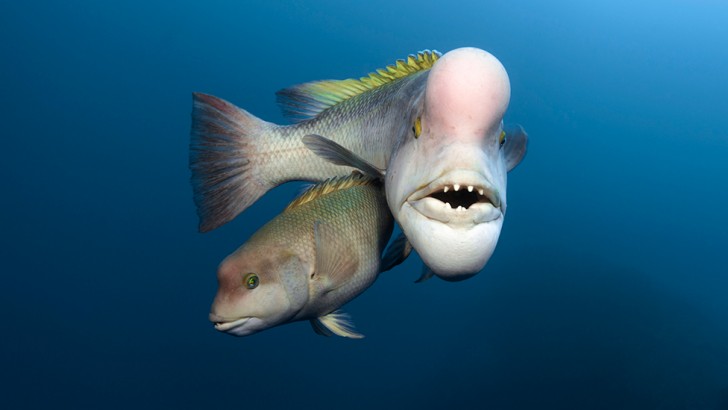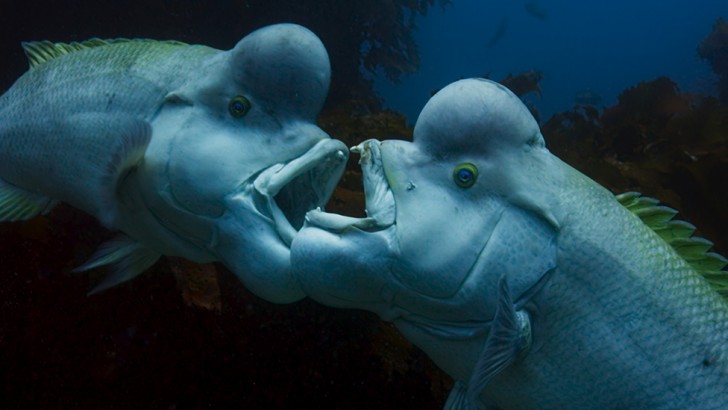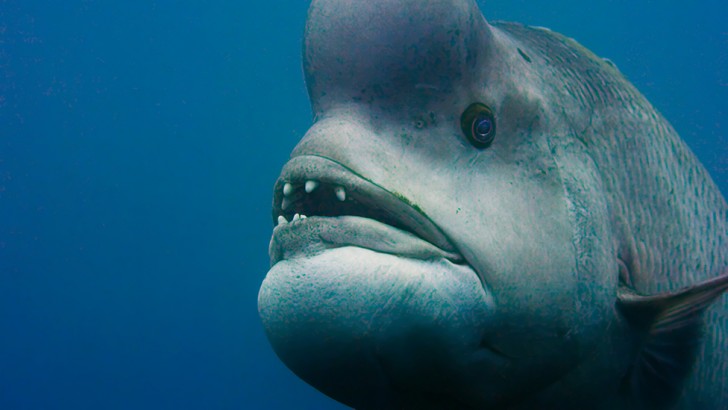Of all the animals, fish are sexually the most fluid.
Millions of people saw a dramatic example of this in the first episode of Blue Planet II, in which a ten-year-old female kobudai (also known as an Asian sheepshead wrasse, Semicossyphus reticulatus) changes into a male. After a two-month hibernation, the transformed male emerges from its lair three times larger than before, bearing testes, a huge bulbous forehead, and an aggressive nature. Now even larger than the existing dominant male it had previously mated with when female, the new male defeats the aged alpha in a violent battle for dominance.
The footage is remarkable – but the transformation is actually not terribly unusual. About two per cent of fish species display some kind of hermaphroditism: that’s 500 different species worldwide.
Some like the kobudai change routinely from female to male. Others, like the clownfish, do the opposite, from male to female. Still others can switch back and forth depending on the circumstance, such as a variety of coral-dwelling gobies. And at least one species, the mangrove killifish, lives a fully hermaphroditic existence, self-fertilizing for their entire reproductive lives.
…and if that wasn’t complicated enough: almost all fish have the capacity to switch sex at the embryonic stage if subjected to one or more of a number of environmental factors, including the acidity of the water, parasites, chemical pollutants, and temperature.
Why should fish range so widely in their gender bending capabilities?
“That is the £60 million question – if I had the answer I’d be in the world’s top journal Nature every week,” says Professor Charles Tyler, a reproductive physiologist at the University of Exeter who studies how environmental contaminants affect fish populations.
The main reason for their extreme plasticity, he says, lies in the sheer number and diversity of species.
“Think about it – fish have been around for 500 million years: today there are more than 26,000 described living species. Compare this to the roughly 200 million years that mammals have been around, and the fact that there’s less than 6,000 species of us,” he says. “There’s simply more diversity in fishes: thanks to evolutionary radiation, they are more widely adapted to a broad range of environmental niches. And where you get variation, you get diversity in all sorts of ways, including how they reproduce.”
Indeed, for many species such as the kobudai, the capacity to switch sex is highly adaptive. If an individual fish can reproduce as a female for the first portion of it’s life, then continue breeding as a male for the rest, it effectively doubles up on its reproductive output. Being able to switch sex maximises the chances of passing on genes if environmental or social circumstances should change.
Many species of fish, like the kobudai, are known as “sequential hermaphrodites”: they can switch sex permanently at a specific point in their lives.
The majority of “sequential hermaphrodites” are known as “protogynous” (Greek for “female first”): they switch from female to male. This includes the kobudai, other wrasses, many species of parrotfish, and a wide variety of reef fish. In most protogynous fish, some fish will start out lives as male, some will switch from female to male at some point, and some will remain as females for the full duration of their lives. However in other species, the sex skew can be more extreme: in the Potter Angelfish, Centropyge potteri, for example, all fish start out lives as females, and all males were at one point female.
Other sequential hermaphrodites are known as “protandrous” (“male first”): males can switch to female at a certain point in their lives, under the right circumstances. Though less common than protogyny, male-to-female sex changes are found in a wide variety of fish, including the Australian barramundi (Lates calcarifer), gilthead seabream (Sparus aurata) and the black porgy (Acanthopagrus schlegeli). In the clownfish Amphiprion clarkii for example, females are larger than males (the opposite of the situation for the kobudai). They live in small groups within protective sea anemones, with one breeding male and female pair and a number of subordinate non-breeding fish. There is seldom more than two breeding fish, due simply to space constraints. When the dominant female dies, the largest male transforms into a female.
As the authors of a 2009 scientific paper in the journal Sexual Development noted, “In the popular cartoon movie Finding Nemo, a male anemonefish loses his mate and must struggle alone to raise his offspring Nemo. In real life, Nemo’s father likely would have switched sex following his mate’s death, and then paired with a male.”
Why the switch-ups? In both protandrous and protogynous species, the “size advantage hypothesis” appears to explain the change: for some fish it is advantageous to be of a different sex once it has reached a certain size. In protogynous fish like the kobudai, where one dominant male holds sway over a harem of smaller females, it’s handy to become male in later life when larger. For protandrous fish like the clownfish, large females are more fertile than smaller ones, so spreading sperm when small and gestating eggs when larger is efficient
However the kings and queens of the sex changing game in fish – known as “bidirectional hermaphrodites” or “serial hermaphrodites” – can change back and forth in either direction depending on environmental circumstances. For example, coral gobies (Gobiodon and Paragobiodon) live within crevices inside coral reefs, move very little during their lifetimes, and have limited opportunity to find new mating partners. If any two fish who happen to find each other can form a male-female mating pair – no matter what sexes they are when they meet – this would be advantageous.
How do fish accomplish this sex-switching mastery? For one, the sex of most fish is not determined by chromosomes: birds and mammals in fact are unusual in having the sex of offspring almost universally determined in this way. Amphibians, reptiles and fish employ a variety of methods to determine the sex of the offspring. Frequently, temperature determines sex – most fish will preferentially develop as male in warmer water, for example.
“It comes down to a very important enzyme called ‘aromatase’,” explains Professor Stefano Mariani of the University of Salford, who studies the evolutionary origins of sex changes in fish. “It is a bit of a molecular wizard: it can change ‘androgen’ hormones into the estrogenic hormones that can transform gonads from ovaries into testes.” Because fish gonads contain the precursor cells for both ovarian and testicular tissue, a rapid flood of either estrogen or testosterone-like hormones can flip a switch and cause new tissue to develop. Moreover, the change can be far more rapid than the two-month transformation of a kobudai – in the bluehead wrasse, the female-to-male transition is complete within just eight days.
The habit of switching sex appears to have developed during fish evolution multiple times in separate families, and though in all of them a suite of genetic and hormonal triggers come into play, the enzyme aromatase appears to be the key.
Moreover, this enzyme is also crucial in what happens in fish who change sex based not on social circumstances but in response to environmental factors. “Because this enzyme is sensitive to temperature, it can be switched on or off depending on how warm the water is,” explains Prof Mariani – hence why more males develop in warmer water.
Other factors, such as chemical pollutants, changes in the acidity of the water, and the bacterial intestinal parasite Wolbachia can all affect the activity of aromatase in developing fish embryos.
In freshwater fish, it is well established that chemical pollutants – such as the pesticide atrazine, fertilizer runoff from livestock operations, ethinyl estradiol (the active ingredient in the birth control pill) – have all skewed the sex populations of wild populations of fish. Even tiny amounts can have profound effects: in one controlled study in Canada, published in the Proceedings of the National Academy of Sciences, researchers artificially kept the level of 17 α-ethinylestradiol constant in an isolated lake for seven years. Result: a steady concentration of just six nanograms per litre of water “feminised” so many male fish into “intersexual fish” that the population completely collapsed.
“And those were pretty darn low levels,” says Professor Maria Sepulveda of Purdue University.
In freshwater ponds and lakes however, pollutants can become concentrated, whereas in the open ocean – even in bays and estuaries – chemicals become quickly diluted. Thus effect of man-made chemicals on fish sex been little studied.
“But just because very few people have looked at this in the marine environment doesn’t mean it’s not a problem – it just means it’s little understood,” says Prof Sepulveda. “If you were to expose a marine fish to a chemical you know induces intersex in a freshwater fish, I would expect to see similar effects.”
Even if evidence for the effect of synthetic pollutants in marine animals is lacking, scientists have already demonstrated that temperature can have a profound effect on the sex ratio of populations – whether marine or freshwater. A 2008 study published in the journal PLoS ONE, surveying 59 species, found that an increase in water temperature of just one to two degrees Celsius can alter the sex ratio from 1:1 to 3:1 (three males for every female) in both oceanic and aquatic species.
Prof Tyler says that if we really want to understand what is going on in the wild – outside research laboratories or isolated lakes in the Canadian wilderness – we need studies that can take into effect the cumulative impact of all the chemicals, hormones, temperature changes and social factors that would combine in the real world. After all, he notes, more than 800 man-made chemicals have been found to interfere with hormones – both masculinizing or feminizing.
“Scientists often miss the big picture because we are trying to look at the effects of one chemical, when we really should be looking at the effects of an entire group of chemicals – combined with other factors such as temperature,” he says. What happens when you combine them?
Prof Tyler demonstrated in the zebrafish Danio rerio – a “model organism” that has had its genome sequenced and been studied in the lab for decades – the combination of the anti-fungal clotrimazole and a five degree change in tank water temperature could lead to a synergistic effect on sex ratios – in other words, not additive, but multiplied.
“We showed that if you combine temperature changes with a pharmaceutical that affects aromatase, the combined effect on sex ratios is much greater than what you would see with individual entities,” he explains.
Or, as the title of the paper harshly puts it: “Climate change and pollution speed declines in zebrafish populations.”
For his part, Dr Mariani isn’t sure if there is sufficient evidence to show that any human factors could be impacting the sex ratios of marine populations – but if anything could, it would be temperature. “I think it’s worth investigating, as it’s a good working hypothesis,” he says.
The impacts of climate change on sex ratios are already worrying marine biologists who study other animals that depend on temperature to determine the sex of embryos. Researchers at the University of Swansea predicted in the journal Nature Climate Change in 2014 that based on the warming scenarios predicted by the Intergovernmental Panel on Climate Change, sex ratios in turtles at the Cape Verde Islands in the Atlantic could skew to up to 90% or more in some patches of sand (warmer temperatures skew the ratio towards female in reptiles, conversely to fish).
However, says lead author Dr Jacques-Olivier Laloë (now at Deakin University in Australia), the main concern isn’t impacts on sex. “The thermal range at which the eggs develop is relatively narrow – if the temperatures in the sand are too low or too high, the eggs won’t develop properly and the embryo will die,” he says. More recent calculations using IPCC data predict that the survival of sea turtle eggs could drop to 59%-79% by 2100.
“There comes a point at which despite having a large female population, the nests just won’t be viable – the eggs will be essentially cooking in the sand.”


